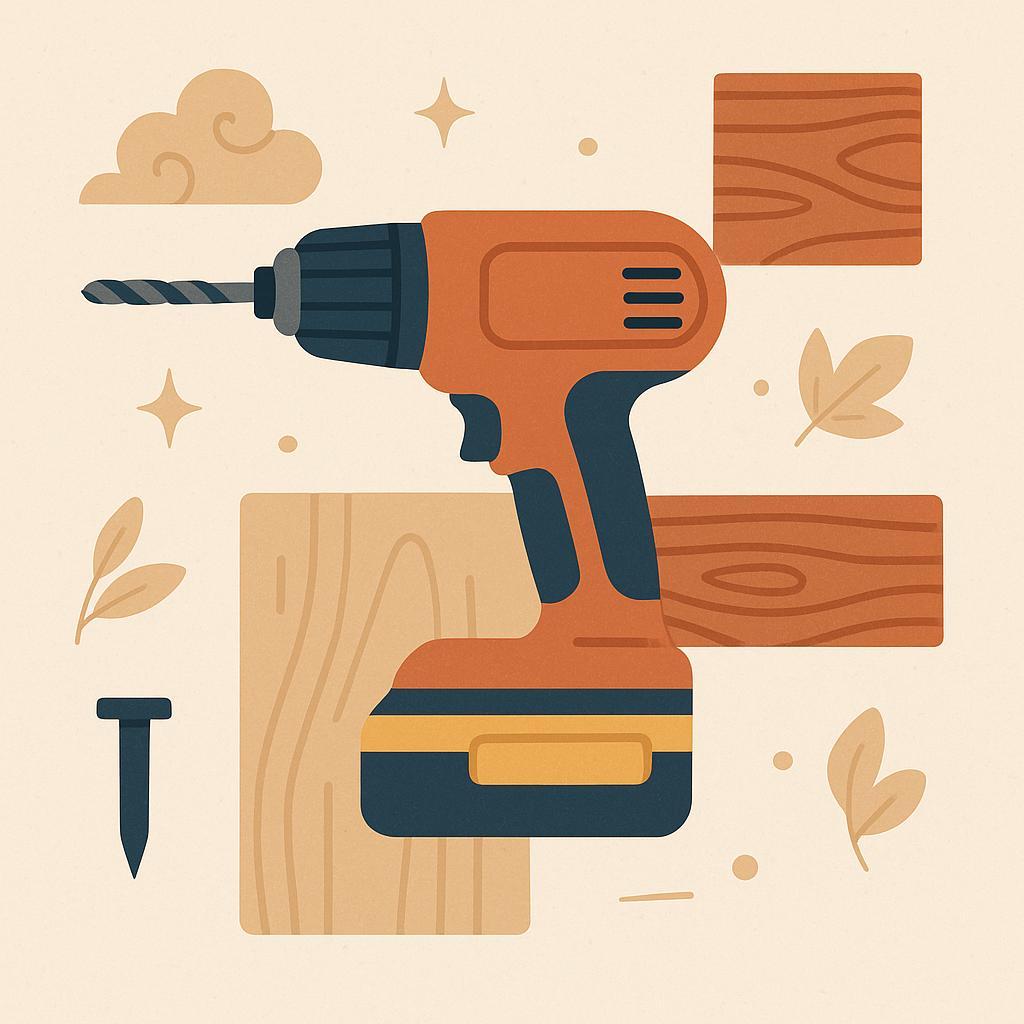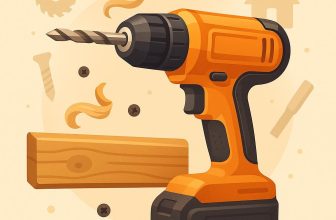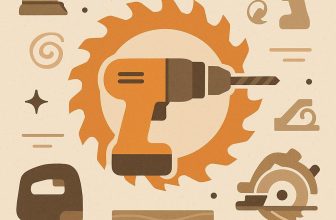
Power without cords, precision without excuses.
In ‘Best Cordless Drills for Woodworking Beginners: 2025 Edition,' that promise is closer than ever for woodworkers starting out.
Cordless drills are the backbone of simple joints, pilot holes, and rapid setups, letting beginners tackle projects anywhere the shop-and inventiveness-take them.
This topic matters because a reliable drill levels the learning curve,boosts confidence,and keeps projects moving when a cordless battery is cold or a cord snag appears.In this guide you'll learn how to choose the right voltage and weight, read specs, compare runtime and bits, and spot value in top models-so you can drill with clarity and momentum.:
Selecting the right cordless drill for woodworking beginners
For woodworking beginners,the right cordless drill is less about brute force and more about control and comfort. Start with a drill/driver rather than a hammer drill, so you can drill pilot holes and drive screws with precision. Look for a compact, well-balanced tool that fits your hand and isn't tiring to use for an hour of assembly. Battery voltage matters: 12V models are light and nimble for small projects, while 20V setups offer more versatility for thicker wood and longer sessions. A brushless motor can deliver smoother power and longer life, tho it may cost a bit more; weigh that against how often you'll use the drill. Practical features to value include variable speed,a reliable clutch with multiple torque settings,a radiant LED for dark work areas,and a quick,keyless chuck for fast bit changes. With these in mind, you'll be ready to tackle everything from pocket holes to simple furniture frames.
To help you compare typical starter options, consider this quick guide to specs that matter most for beginners:
| Feature | Why it matters | Beginner tip |
|---|---|---|
| Voltage | Higher power and torque; handles thicker wood | Choose 12V for light work, 20V for versatility |
| Clutch settings | Prevents stripping or overdriving screws | Look for 20+ clutch positions |
| Speed range | Control drilling vs driving | 0-500 rpm (drilling), 0-1500 rpm (driving) |
| Chuck type | Ease of bit changes | Keyless chuck, 1/4″ or 3/8″ |
| Weight | Impact on fatigue | Target under 3 lb (unloaded) |
Beyond specs, think about the ecosystem and budget. If you already own batteries for a specific brand, sticking to that family can save money and spare you from buying duplicate chargers.Check whether the drill you choose accepts common accessories (12V tools or 20V). A simple two-battery kit with a fast charger is a solid starter setup that keeps you drilling longer between charges.Also review warranty terms and service options; a brushless motor frequently enough pairs well with extended warranties, but even entry-level models typically offer at least a one-year period that covers defects.
test handling before you commit. In-store, pick up different models and note weight distribution, grip texture, and trigger sensitivity. Ask staff to demonstrate the drill with a standard bit and a screw; confirm that the clutch clicks smoothly through several settings and that bit changes feel effortless without wobble. A well-chosen drill becomes a natural extension of your workspace,turning rough-cut boards into clean joints with confidence and less fatigue.
Build Your Dream Workshop on a Budget →
Power and speed essentials for precise wood projects with a cordless drill
Power and speed go hand in hand when you're chasing clean, precise results in wood. A cordless drill that offers controlled torque and a responsive trigger helps you start cleanly and finish with minimal tear-out. Look for models in the 18-20V range with a variable-speed trigger, a solid chuck, and a clutch that lets you dial in the right amount of twist. A brushless motor is a nice-to-have for smoother operation and longer life, especially if you'll be drilling many pilot holes or driving a lot of screws.
Understanding the relationship between speed and torque lets you tailor the drill to each task.Start slow, then speed up as the bit bites. For pilot holes in softwood, set a low-to-mid clutch (roughly 3-6) and use a light touch to minimize wandering. When driving screws, drop the speed and choose a clutch that prevents cam-out, typically around 4-6 for medium screws and higher for larger jobs. If you're drilling through hardwoods, maintain steady pressure, use sharp bits, and let the bit do the work with careful, controlled feeds.
Practical techniques for precision start with a square approach: clamp the work,keep the drill perpendicular,and mark your starting point with a center punch. begin with a small pilot hole before the final bit, and consider a backer board to reduce tear-out at exit. Use brad-point bits for wood to minimize wandering,and for clean countersinks,ease into the cut with a light touch. If edges are involved, a drill guide or jig can help you stay square and consistent.
Here's a concise snapshot of clutch and speed guidance for common wood tasks:
| Task | Clutch (approx) | Speed | Notes |
| Pilot holes in softwood | 3-6 | Low to mid | Minimize tear-out |
| Pilot holes in hardwood | 5-7 | Mid | Drill straight, steady feed |
| Driving small screws | 4-6 | Low | Prevent cam-out near edges |
| Drilling large holes | 6-8 | Mid to high | Let bit cut; backer board helps |
Build Your Dream Workshop on a Budget →
Ergonomics and balance for comfortable long woodworking sessions
Ergonomics starts with how you hold the drill and how you stand. A well-balanced tool reduces strain on your wrists and shoulders during long sessions.When selecting a cordless drill, look for a comfortable grip that fits your hand, a weight that you can lift without fatigue, and a barrel that allows you to keep a near-vertical neutral wrist. Practice a natural stance: feet shoulder-width apart, knees slightly bent, and elbows tucked in to keep your center of gravity stable.
Plan your grip and hand placement before starting a cut. A pistol grip with a soft overmold often feels steadier than a bare metal handle for many beginners.If the drill includes an auxiliary side handle, use it to distribute force and maintain control, especially when drilling into harder wood or driving screws. Keep your wrists in a neutral position and avoid overreaching; short, controlled motions are more comfortable over long projects. Consider anti-vibration features or gloves that dampen recoil without reducing feedback.
| Feature | Why it helps | Tip |
| Weight | Less fatigue over extended use | Look for under 3 lbs (1.4 kg) |
| Balance | Center of gravity near the handle | Test by lifting vertically from the mid-grip |
| Grip | Soft, non-slip overmold | Try with gloves and bare hands |
From a practical standpoint, a few setup tweaks pay back during long sessions. Align the drill chuck with your forearm so you can drill with minimal wrist twist. Use a work surface at elbow height and a stable stance to avoid leaning into the tool. Keep your shoulders relaxed, and switch hands or take short breaks to prevent repetitive strain.
tailor the drill's ergonomics to your body. Try several grip styles in the store and compare balance by holding the tool at mid-point and at full extension. Pair your drill with an anti-vibration solution if you notice hand numbness, and schedule regular micro-breaks to reset posture. With a focus on balance and mindful technique, you can extend comfortable woodworking sessions without sacrificing accuracy.
Build Your Dream Workshop on a Budget →
Battery life strategies and charging habits for uninterrupted cordless work
Reliable runtime from cordless drills starts with smart charging habits and keeping batteries in peak condition. Most contemporary packs use lithium-ion cells, which handle frequent recharges well and deliver high energy density without excessive weight. To keep your woodworking flowing, aim to prevent deep discharges, rotate between two or more batteries, and plan swaps so you're rarely waiting for a recharge mid-project.
On the job, plan for downtime by using proactive practices that keep you drilling.
- Swap to a fresh battery when the current one drops to about 20-30% to avoid reduced torque and stalls.
- Keep at least one charged spare handy; label batteries for each drill model so you can grab the right pack quickly.
- Use a smart charger with temperature sensing and automatic shutoff to prevent overcharging.
- Avoid charging on hot surfaces, in direct sun, or inside a vehicle; let packs come to room temperature before connecting the charger.
Storage and temperature matter for long-term health. When you're not using the drills, follow these guidelines to extend pack life and readiness.
| Scenario | recommended Action | Notes |
|---|---|---|
| Daily use | Charge before starting and top up after finishing | Keep packs in a cool, ventilated area |
| Storage (weeks) | store at 40-60% charge in a cool, dry place | Avoid heat exposure |
| Rapid recharge | Use a charger matched to pack capacity; avoid repeated full-charge cycles | Fast charging can generate heat |
Quick-start checklist for battery care and charging habits:
- Inspect battery contacts and clean if needed; re-seat packs firmly before use
- Keep chargers and batteries dry and away from moisture
- Label batteries and chargers; maintain at least one spare charged for job sites
- Plan usage by mapping tasks that will demand more power to minimize downtime
Build Your Dream Workshop on a Budget →
Must have features and how to compare cordless drills for woodwork
When choosing a cordless drill for woodwork, aim for a tool that balances power with precision.A comfortable grip, well-distributed weight, and a responsive trigger help you work longer without fatigue. Look for a broad torque range with a clutch that offers many settings so you can drive screws gently through soft pine or confidently through hardwood without cam-outs. A compact, well-balanced design keeps your control steady on edge work, dado slots, and tight corners.
Power and endurance matter for real-world sessions. A brushless motor tends to run cooler and last longer, while a compatible platform (18V/20V max) gives you access to a wide ecosystem of batteries and kits. Prioritize at least two batteries and a fast charger so you can swap packs and keep drilling. For woodworking, value a tool that maintains steady torque and avoids stalling in hardwoods more than high no-load RPM.
- Battery strategy: 2 batteries or more, and a fast charger to minimize downtime.
- Motor type: Brushless for longevity and efficiency.
- Torque and clutch: A wide, easily adjustable clutch range.
- Weight and balance: Under 3-4 lbs (1.3-1.8 kg) for comfortable one-handed use.
- Chucks and bits: Quick-change chuck (1/4″ hex or 1/2″ keyless) for fast bit swaps.
Practical handling touches make a big difference in wood projects. A bright LED work light helps reveal grain and alignment in dim spaces, while a glove-pleasant ergonomic grip reduces strain. Consider whether you want a compact drill/driver or a kit with an impact driver and extra bits,as your choice influences your sanity and budget. check for handy extras like a magnetic bit holder, belt clip, or onboard bit storage so you're not hunting for bits mid-project.
To compare models efficiently, focus on the core specs that matter in woodwork and use a quick side-by-side frame for your notes. Use the table below as a cheat sheet:
| Feature | Why it matters for woodwork | What to look for |
|---|---|---|
| Voltage / platform | Power feel and battery ecosystem | 18V/20V max; choose one compatible with needed kits |
| Motor type | Efficiency and durability | Brushless preferred |
| Torque / clutch | Control through hardwoods and varied screws | Wide adjustable range with a solid stopping point |
| weight | One-handed control and reduced fatigue | Aim for ~3-4 lbs (1.3-1.8 kg) |
| Chuck & bits | Ease of bit changes | 1/4″ hex quick-change or 1/2″ keyless chuck |
| Battery life & charging | Session length without downtime | Higher Ah packs + fast charger |
Build Your Dream Workshop on a Budget →
Budget friendly cordless drill picks and practical recommendations
For beginners on a budget, the goal is to get reliable drilling power without overspending. In woodworking, a compact, balanced 18V-20V class drill/driver with a comfortable grip, a 1/2″ chuck, and a solid clutch is usually enough for dowels, pilot holes, and small mortises. Look for variable speed, adequate torque, and a couple of spare batteries in the kit to keep you moving rather than waiting on a recharge. The right battery ecosystem (same brand across your tools) will save you money and hassle as you add a sander, jigsaw, or router later.
Below are four budget-friendly picks that tend to deliver reliable performance for common woodworking tasks. Each entry balances weight, power, and value, so you can start building projects today without a large upfront investment.
| model | Voltage | Chuck | Why it's good for beginners | Approx.price |
|---|---|---|---|---|
| Ryobi one+ P208 | 18V | 1/2″ | Lightweight, strong value, widely compatible with One+ batteries | $60-$90 |
| BLACK+DECKER 20V Max LDX120C | 20V | 3/8″ | Extremely affordable; simple controls; great starter option | $40-$60 |
| DEWALT 20V MAX DCD771C2 | 20V | 1/2″ | Solid torque, reliable performance, widely available | $99-$129 |
| Porter-Cable PCC620B | 20V | 1/2″ | Budget-friendly, balanced features, good for core drilling tasks | $45-$85 |
Beyond the model picks, practical buying tips can stretch your dollars further. Choose a kit with at least one spare battery to avoid downtime, and consider a lightweight drill if you'll be drilling overhead or working on narrow pieces. For woodworking,a 1/2″ chuck and a variable-speed range that starts slow for pilot holes and ramps up for larger bits are worth prioritizing.If you see brushed models offered at a considerably lower price,they're usually fine for beginners; you'll get more life out of a brushless option only if you expect frequent,long sessions.
Plan for growth by sticking with brands that offer a broad ecosystem of tools. A compact carrying case, a basic bit set, and a spare battery are small investments that pay off as your projects scale. Check return policies and warranties, and don't hesitate to test the grip and balance in-store-the right feel can make long sessions more enjoyable and accurate.
Build Your Dream Workshop on a Budget →
Q&A
What features should beginners look for in a cordless drill?
Choose a model that is lightweight and well-balanced for comfortable control. Look for at least a 3/8-inch chuck (1/2-inch is nicer), a variable-speed trigger, and a multi‑position clutch to protect bits and materials. A reliable Li‑ion battery with decent runtime, quick charging, and a comfortable grip with good LED lighting makes long sessions easier.
How do I choose the right voltage and torque for woodworking?
Voltage sets the power ceiling, so for beginners a 12-20V drill/driver is a practical range-lighter handles with less weight at the lower end, stronger models at the higher end. Focus on a solid clutch with multiple settings and a sensible maximum RPM to avoid overdriving screws or wandering when drilling. In practice, pick a drill/driver that balances weight, control, and enough torque for your projects without becoming tiring.
is a drill/driver kit worth it for beginners?
Yes. A kit with extra batteries and a charger reduces downtime and keeps projects moving.It also helps you learn with a consistent feel and balance, so you gain confidence as you build your toolkit.
What common mistakes should beginners avoid when using a cordless drill for woodworking?
Avoid rushing: fit the right bit, clamp your work, and pilot holes when needed. Start with low torque and steady speed to prevent bit walking, then increase gradually. Keep dull bits out of service, and practice safe handling to protect yourself and the workpiece.
Concluding Remarks
To wrap up: the best cordless drill for a woodworker starting out is not the flashiest model but the one that fits your hand, lasts long enough to finish your project, and gives you control without strain.Key takeaways: prioritize ergonomics, reliable battery, variable speed with a solid clutch, and a chuck that handles common bits. the right tool matters because it turns intentions into smooth, accurate work and keeps the learning curve kind to your developing skills. So pick a project, check the guides, and apply what you learned. With patience and persistence, your workshop becomes a place of confident, satisfying creation.







Great article! I’m just starting out in woodworking and your recommendations for cordless drills are super helpful. Can’t wait to try out some of these options!
Thanks for sharing this info! I’m also new to woodworking, and it’s so helpful to have a guide on which cordless drills are beginner-friendly and budget-conscious. Looking forward to my first project!
I appreciate the insights in this article! As a beginner, finding the right tools can be overwhelming, but your suggestions for budget-friendly cordless drills make it so much easier to get started on my woodworking journey!
I’m so glad I found this article! As someone just starting in woodworking, the detailed reviews and comparisons of cordless drills are exactly what I needed to make an informed choice. Excited to dive into my projects!
Thank you for this fantastic guide! As a novice woodworker, I found your recommendations for cordless drills incredibly useful. It’s reassuring to know there are good options out there that won’t break the bank. Ready to get started on my first project!
This guide is a lifesaver! As a beginner in woodworking, it’s tough to know where to start, and your curated list of cordless drills takes the guesswork out of the equation. I’m excited to pick one and finally begin my woodworking adventure!
This article is a game-changer for anyone starting out in woodworking! I love how you highlighted drills that are not only easy to use but also affordable, making it perfect for beginners like me. Can’t wait to pick one and start crafting!
This post is incredibly helpful for all the aspiring woodworkers out there! The way you broke down each drill’s features and suitability for beginners makes it so much easier to choose the right one. I’m really looking forward to starting my projects with the perfect tool in hand!
This is such a valuable resource for beginners! The way you broke down the features of each drill really makes it easy to understand what to look for when starting out in woodworking. I’m eager to pick one and begin working on my first project!
This is such an insightful post! I appreciate how you’ve tailored your recommendations for beginners, making it so much less daunting to choose the right drill. I’m feeling more confident about diving into woodworking and can’t wait to start my first project with one of these great tools!
This is such a fantastic guide for newbies looking to get into woodworking! Your detailed analysis of each drill really helps clarify what features are best for beginners, and I appreciate the emphasis on usability and value. I’m ready to choose my first drill and kickstart my woodworking journey!
This guide is a lifesaver for anyone new to woodworking! I love how you’ve made the selection process simple and straightforward, focusing on what really matters for beginners. I’m excited to choose my first cordless drill and see where this journey takes me!
What an excellent guide! I’m so grateful for the clear breakdown of features tailored for beginners; it really takes the intimidation out of selecting my first drill. I’m excited to embark on my woodworking journey with the right tools!
This guide is exactly what I needed as a woodworking novice! The way you’ve highlighted the essential features for beginners takes away so much of the guesswork, and I can already feel my excitement building up to pick my first cordless drill. Thank you for making this journey so much more accessible!